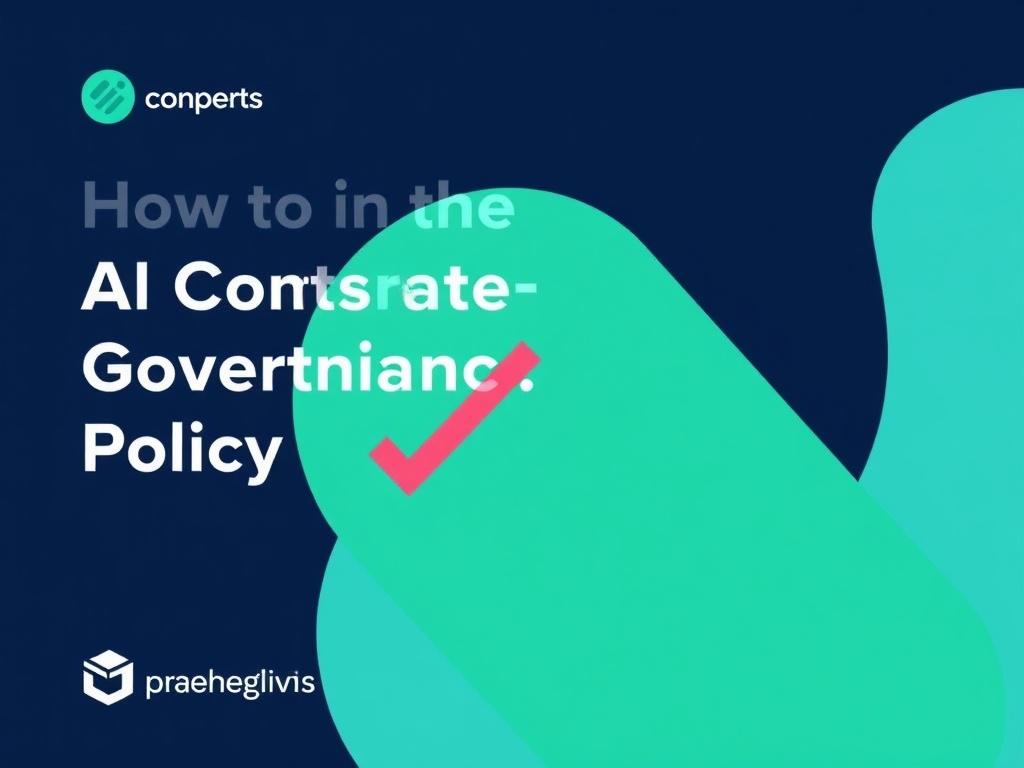Every team that uses AI to create, edit, or publish content eventually faces the same question: who sets the rules, and how do we make sure those rules are followed? Whether you’re a small marketing group experimenting with generative tools or a large enterprise integrating AI into product documentation, a clear AI content governance policy keeps your work consistent, ethical, and legally safe. This article walks you through designing and implementing a policy that fits your organization’s culture and risk profile. The guidance is practical, step-by-step, and written in a friendly, conversational tone so you can use it right away.
We’ll cover what content governance means in an AI context, why it matters, the essential components of an effective policy, the roles and responsibilities you should define, how to assess risk, and the tools and processes that make governance operational. There are checklists, a sample policy snippet, a responsibilities table, and a playbook you can adapt. Read on, and by the end you’ll have a clear roadmap for creating a policy your team will actually use.
Why AI Content Governance Matters

AI-generated or AI-assisted content changes the rules of content production. Speed and scale are great, but they bring new risks: hallucinations, copyright issues, bias, inconsistent brand voice, data privacy risks, and regulatory exposure. Without a governance policy, teams can drift into risky practices simply because the tools make it easy to do so. A governance policy creates guardrails that preserve quality, trust, and compliance without killing innovation.
Think of governance not as a bureaucratic straitjacket but as a playbook for creativity. It helps you: 1) set clear expectations, 2) reduce friction when making decisions, 3) assign accountability, and 4) enable auditability and continuous improvement. When done right, governance empowers your team to use AI confidently—and to take calculated risks that move the business forward.
Core Principles to Guide Your Policy
Before diving into the mechanics, establish a few core principles that will shape every rule you write. These principles act as a compass when trade-offs are needed.
- Transparency: Be clear about AI use internally and externally when appropriate.
- Accuracy: Hold content to the same factual verification standards as non-AI content.
- Accountability: Assign human ownership for all content produced with AI assistance.
- Privacy and Safety: Protect sensitive data and avoid generating content that causes harm.
- Continuous Improvement: Iterate on the policy as tools and risks evolve.
These principles should be short, memorable, and visible in the policy’s opening section so every teammate understands the intent behind the rules.
Step-by-Step Process to Build the Policy
Developing a governance policy is a deliberate process. Here’s a step-by-step approach that teams of any size can follow. You don’t need to get every detail right on the first pass—start, test, and refine.
Step 1: Convene the Right Stakeholders
Bring together people who will use AI, those who will be affected by AI content, and those who manage risk. Typical participants include content creators, editors, legal counsel, data protection officers, product managers, and an IT or security representative. This cross-functional group ensures the policy is practical and enforceable.
Kick off with a short workshop to align on objectives, principles, and scope. Use the workshop to collect real-world examples of AI use cases within the team—that will guide your risk assessment.
Step 2: Map Existing Workflows and AI Touchpoints
Document where AI enters your content lifecycle: ideation, drafting, editing, localization, publishing, or monitoring. For each touchpoint, note which tools are used (e.g., generative models, summarizers, language translators, image generators), what data they access, and who interacts with them.
This mapping reveals where the biggest risks and opportunities lie and tells you where controls need to be focused.
Step 3: Conduct a Risk Assessment
Assess risks across multiple dimensions: factual accuracy, copyright and IP, personal data leakage, regulatory compliance, reputational harm, and bias. For each content type (marketing, legal, product, customer support), evaluate both likelihood and impact.
Use a simple qualitative matrix (low/medium/high) or a quantitative scoring system to prioritize controls. Prioritization helps you allocate resources to areas with the highest risk-reward balance.
Step 4: Define Roles and Responsibilities
Clear ownership prevents content from falling through the cracks. Your policy should name who is responsible for drafting, reviewing, approving, publishing, and auditing AI-assisted content. Roles are often split across creator, reviewer/editor, approver (e.g., subject matter expert), compliance reviewer, and an AI governance lead.
Make sure responsibilities include verification protocols: who fact-checks claims, who verifies sources, and who ensures compliance with license terms for model outputs or third-party content.
Step 5: Set Acceptable Use Rules and Standards
Define what AI should and should not be used for. Be concrete. For instance, you might allow AI for first-draft creation and brainstorming but require human review for customer-facing claims or legal language. Provide examples of acceptable and unacceptable uses to reduce ambiguity.
Also establish style, tone, and brand voice rules specifically when AI is expected to mimic brand language. AI should be treated like another author in your editorial guidelines.
Step 6: Specify Data Handling and Security Controls
AI tools often send data to external services. Specify what kinds of content are forbidden to input into public or unsecured models (e.g., customer personal data, undisclosed financials, private source code). Define approved tools and procedures for sharing sensitive content with vendor-hosted models, such as anonymization, internal hosting, or vendor contractual guarantees.
Include technical controls (API restrictions, access controls, logging) and process controls (approval flows, training, and onboarding) to minimize data exposure risks.
Step 7: Create Review and Approval Workflows
Design a lightweight but effective review process that matches the risk level of the content. Low-risk content may need only a quick editor review, while high-stakes content should have subject matter expert signoff and a compliance review. Document the steps and expected timelines so work doesn’t stall.
Consider automated checkpoints (e.g., prompts to check for PII or fact-check links) integrated into the tools you use.
Step 8: Implement Monitoring, Auditing, and Logging
To enforce policy and learn from mistakes, implement monitoring. Maintain logs of AI tool usage, prompts, model versions, generated outputs, and approval records. These logs support audits, incident investigations, and continuous improvement.
Decide a retention policy for logs that balances forensic needs with storage costs and privacy considerations.
Step 9: Train Your Team and Build a Culture of Responsible Use
A policy is only effective if people know it and buy into it. Develop training that covers the rationale, examples, common pitfalls, and hands-on practice. Mix quick reference guides with deeper workshops.
Promote a culture that encourages asking questions and reporting incidents without fear of punishment. Recognition for people who flag issues or improve processes helps reinforce the right behavior.
Step 10: Review and Iterate Regularly
AI tools and regulations change rapidly. Schedule regular policy reviews—quarterly for fast-moving teams, semi-annually elsewhere. Use audits and incident reports to update rules and training. Treat the policy as a living document.
Key Policy Components and What to Include
Now let’s get specific about the sections your policy should contain. Treat this as a template you adapt to your context.
1. Purpose and Scope
Explain why the policy exists and what it covers. Be explicit about which teams, content types, and tools are within scope, and which are out of scope.
2. Definitions
Define important terms such as “AI-assisted content,” “model hallucination,” “sensitive personal data,” and “approved vendor.” Clear definitions prevent confusion later.
3. Principles and Standards
List the governance principles (transparency, accuracy, etc.) and editorial standards (citations, evidence, tone). These anchor practical rules that follow.
4. Roles and Responsibilities
Document who does what. Use a RACI (Responsible, Accountable, Consulted, Informed) approach if helpful.
5. Acceptable Use and Prohibited Uses
Clarify allowed and disallowed activities. Provide examples for clarity.
6. Data Protection and Privacy
Detail what data can be input to models, how to handle PII, and vendor evaluation criteria for data security.
7. Review and Approval Process
Describe the steps content must pass through before publication, including required signoffs for high-risk items.
8. Logging and Audit Trail Requirements
Specify what must be logged (prompts, outputs, reviewer names, timestamps) and retention periods.
9. Training and Onboarding
Specify required training for new hires and ongoing refreshers. Link to training materials and quick reference sheets.
10. Incident Management
Define what qualifies as an incident, reporting channels, response time expectations, and remediation steps.
11. Vendor and Tool Selection Criteria
Provide a checklist for evaluating third-party AI products: data residency, model transparency, SLAs, compliance certifications, and ability to disable or log the service.
12. Compliance and Legal Considerations
Address specific regulatory requirements the team must follow (advertising rules, healthcare privacy, financial disclosure rules), and tie into the broader legal/compliance framework of your organization.
Sample Roles and Responsibilities Table
Below is a simple table you can adapt to your organizational structure. It clarifies who is accountable at each stage of the content lifecycle.
| Role | Responsibilities | Typical Owners |
|---|---|---|
| Content Creator | Drafts content using AI tools, documents prompts used, flags potential issues | Writers, Designers |
| Editor / Reviewer | Checks accuracy, brand voice, and compliance with policy; logs approvals | Editors, Team Leads |
| Subject Matter Expert (SME) | Verifies factual claims and technical accuracy for high-risk content | Engineers, Legal, Product Managers |
| Compliance / Legal | Evaluates regulatory and IP risk, approves high-stakes content | Legal Counsel, Compliance Officers |
| AI Governance Lead | Maintains the policy, oversees audits, and coordinates training | Program Manager, Chief of Staff |
| IT / Security | Manages tool access, logs, vendor security assessments | Security Engineers, IT Ops |
Practical Controls: Examples and Templates
Here are concrete controls you can adopt. Pick the ones that match your risk profile and scale them as needed.
Content Tagging and Metadata
Require metadata for all AI-assisted content: tool used, model version, prompt or instruction, creator, reviewer, and approval date. This builds an audit trail and helps analyze tool performance over time.
Prompt Logging Template
Capture prompts in a structured way:
- Prompt ID
- Creator
- Tool and model version
- Prompt text
- Output snippet
- Reviewer and approval status
Approval Matrix
Create simple rules tying content risk to approval requirements. For example:
| Risk Level | Examples | Approvals Required |
|---|---|---|
| Low | Blog drafts, internal brainstorming notes | Editor sign-off |
| Medium | Customer-facing emails, product descriptions | Editor + SME |
| High | Regulatory claims, legal text, medical advice | Editor + SME + Legal/Compliance |
Vendor Assessment Checklist
When evaluating AI vendors, ask these questions:
- Where is data stored and processed?
- Can the vendor guarantee not to use our data to train their public models?
- What logging and traceability features are available?
- What certifications (ISO 27001, SOC 2) does the vendor hold?
- Does the vendor support on-premise or private cloud deployment if needed?
- How is model versioning handled and communicated?
Operationalizing the Policy: Tools, Templates, and Integrations
Policies are words; operations make them real. Adopt a mix of tooling to support the policy without slowing creativity.
Tooling Suggestions
- Prompt Managers and Repositories: Store and reuse verified prompts and templates.
- Version Control: Use git or content versioning for transparency.
- Access Controls: Integrate AI tools with SSO and role-based permissions.
- Metadata Automation: Add prompts and model metadata automatically via tool integrations.
- Monitoring Dashboards: Track usage patterns, costly API calls, or spikes in content generation.
- Detection Tools: Use classifiers or watermarking where feasible to detect unapproved AI output.
Integration with existing CMS, workflow, and security systems reduces friction and ensures consistent application of the policy.
Training and Change Management
Training should be practical and ongoing. Create modules for different audiences: creators, reviewers, and execs. Training for creators focuses on prompt hygiene, bias awareness, and what not to input into models. Reviewers learn verification techniques and how to judge AI outputs. Executives get a high-level briefing on risks, metrics, and governance process.
Use role-play, sample incidents, and hands-on exercises. Encourage knowledge sharing by capturing interesting incidents (both successes and near-misses) in a learning repository.
Measuring Success: Metrics and KPIs
A policy is effective only if you can measure its impact. Define metrics that are meaningful to your team and stakeholders.
- Compliance Rate: Percentage of AI-assisted content that followed the prescribed review workflow and metadata requirements.
- Incident Rate: Number of incidents (e.g., factual errors, privacy breaches) per month.
- Time to Publish: Time from draft to publish, to ensure governance isn’t causing excessive delays.
- Tool Utilization: How often approved tools are used versus unapproved ones.
- Training Completion: Percentage of staff who completed required training.
Report these KPIs regularly to stakeholders and use them to prioritize policy improvements.
Common Challenges and How to Overcome Them
Rolling out an AI content governance policy comes with predictable pushback and obstacles. Here are common challenges and practical ways to address them.
Challenge: Perceived Bureaucracy
Solution: Start with minimal viable controls and focus on high-risk areas. Make reviews lightweight and provide tooling that automates metadata capture to reduce manual work.
Challenge: Rapid Tool Churn
Solution: Maintain an approved tool list and a fast-track evaluation process for new entrants. Use sandbox environments to test new tools safely.
Challenge: Lack of Expertise
Solution: Build internal champions and provide practical training. Bring in external consultants for initial vendor assessments and technical controls if needed.
Challenge: Balancing Speed and Safety
Solution: Use tiered approval workflows and allow editors to expand the scope of quick approvals as confidence grows. Track time-to-publish to ensure controls don’t create unacceptable delays.
Real-World Examples and Use Cases
Here are a few scenarios to illustrate how an AI content governance policy works in practice.
Marketing Team Using Generative Copy
A marketing writer uses an AI model to draft ad copy. Under policy, the writer logs the prompt and output, an editor checks for brand consistency and regulatory claims, and metadata is attached before scheduling in the CMS. For high-spend campaigns, the copy also gets a compliance review.
Customer Support Using AI to Draft Responses
Support agents use AI to draft responses. The policy restricts the input of customer PII into the model, mandates an internal knowledge base as the source of truth, and requires a human to sign off on responses for escalated tickets.
Product Documentation Generated with AI
Technical documentation is drafted with AI but must be reviewed line-by-line by an engineer (SME). Any code snippets generated by AI are treated as untrusted and must be validated and tested by the owner before publishing.
Sample Policy Snippet You Can Reuse

Below is a short policy excerpt you can adapt. It’s written in plain language so teams can adopt it quickly.
Policy Excerpt: All AI-assisted content must be logged with the tool and model used, the original prompt, the creator’s name, and the reviewer’s approval. Customer personal data, confidential financial information, and proprietary source code may not be entered into public or unapproved models. AI can be used to generate first drafts and brainstorming content, but all customer-facing claims, legal text, and regulated content require SME and legal sign-off prior to publication. The AI Governance Lead is responsible for maintaining the approved tools list, organizing quarterly audits, and ensuring the team completes mandatory training. Violations must be reported within 24 hours to the AI Governance Lead and Compliance.
Checklist: Quick Launch for Small Teams

If you’re a small team that needs quick governance, use this bite-sized checklist to get started in a week.
- Write a one-page policy with purpose, scope, and a short list of allowed/disallowed uses.
- Create an approved tools list and name one person responsible for updates.
- Define roles (creator, reviewer, approver) and publish a one-line approval matrix.
- Start logging prompts and outputs in a shared document or simple database.
- Run one hands-on training session and make recording available.
- Schedule a monthly review to iterate based on issues found.
When to Escalate to Legal or Compliance
Certain scenarios require legal or compliance involvement. Escalate when content: 1) makes regulated claims (health, finance); 2) could affect stock or investor relations; 3) involves sensitive personal data or data subject rights; 4) includes potential IP risk (using copyrighted training data); or 5) may result in reputational damage. Include escalation triggers and contacts in the policy so teams know exactly what to do.
Future-Proofing Your Policy
AI is evolving quickly. Keep your policy adaptable by focusing on principles rather than rigid, tool-specific rules. Maintain a process for rapid vendor evaluation, and consider emerging standards such as watermarks, model cards, and standardized transparency reports. Engage with industry groups and legal counsel to monitor regulatory changes and update the policy accordingly.
Resources and Further Reading
Equip your team with resources: internal quick-start guides, a prompt library, vendor evaluation checklists, and links to external guidance from regulators or industry groups. Curate case studies and postmortems—learning from real incidents is one of the fastest ways to improve governance.
Conclusion
Developing an AI content governance policy doesn’t have to be daunting: start with clear principles, involve the right people, map where AI touches your workflows, and put in place simple, enforceable controls that match your risk profile. Focus on metadata and logging, define roles, build lightweight review workflows, and train your team so governance becomes part of everyday practice rather than an obstacle. Regularly review the policy, measure its effectiveness with a few key KPIs, and adjust as tools and regulations evolve—this keeps your team nimble, reduces risk, and allows you to harness AI’s potential responsibly and confidently.
